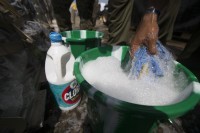Why Reach for Bleach? Biohazards and Bleach Cleaning

When deep cleaning our homes, why do we reach for bleach?
Most of us have used bleach at one time or another, whether as a laundry aid or a household cleaner. Bleach is preferred because it is not only cheap and readily available, but considered very effective against the spread of bacteria. Our grandmothers swore by its cleaning power, and many trusted resources on household maintenance sing its praises for a variety of uses, but recent articles illustrate the dangers of overuse. A recent study conducted on households using bleach reported that children living in these homes were significantly more likely to experience respiratory issues. Further, homes where “passive contact” with bleach occurred were also 20% more likely to have an outbreak of the flu. (SOURCE: Techtimes, 4/4/15).
What is Bleach?
Bleach (sometimes called chlorine bleach) is a common name for products that contain the chemical sodium hypochlorite. Because it kills many bacteria and viruses, it is considered a pesticide.
The U.S. Environmental Protection Agency (EPA) regulates antimicrobial products as pesticides, requiring manufacturers to clearly label bleach and other products with instructions for use as well as warnings and other information. Close attention should be paid to these directions, or serious hazards may result.
Which Bleach Should I choose?
Not all bleaches are considered equal. As a general-purpose cleaner or whitening agent, bleach is used on household surfaces and in laundry. In this case, it is not intended to act as a pesticide so it does not require EPA registration. Disinfectant instructions will not be included on the label. As a pesticide, bleach is used to disinfect surfaces. In this case, the label must include an EPA registration number that indicates the products designated use and directions about how to use the product effectively in the manner it is designed for.
Products approved by the EPA as disinfectants are intended to work on hard surfaces only. Any claim that these products remove harmful bacteria or viruses from porous surfaces such as carpet or fabric are inherently false. In addition, while bleach is effective against mildew, Clorox and other companies maintain it is NOT useful against mold. This contradicts many of the internet articles and blogs that suggest otherwise. As with other tough biohazard cleanup situations, mold should be handled only by a professional remediation company. Because Aftermath Services specializes in crime scene and communicable disease cleanup, we do not perform mold removal or related cleanup.
What are the dangers of using bleach?
No matter what the intended use, bleach is a harsh chemical that should be used with caution. Not only can it strip the color out of fabrics, but its caustic properties can also damage hard surfaces. Furthermore, bleach is meant to be used in only well-ventilated areas. No matter how small the quantity, serious respiratory ailments may occur if used indoors and in closed spaces.
In addition to these obvious risks, one of the most concerning factors regarding the use of bleach is improper application. As a chemical, bleach interacts with other chemicals. Never mix bleach with ammonia or other cleaning agents, or serious injury may result. Like many disinfectants, bleach requires very specific conditions in order to be effective against germs and viruses. Curing time as well as dilution ratio are two things to consider when using bleach as a cleaner. Read the label carefully. Also, never pour straight bleach on any surface – not only can it damage the surface, but it will actually be ineffective without proper dilution.
What are the alternatives to using bleach?
As long as a product is registered with the EPA as a sanitizer or disinfectant, and is used according to the label, it can be used as an anti-microbial cleaner. Alternatives to bleach that are registered with the EPA are generally grouped as: quaternary ammonium compounds, iodine based sanitizers, acid anionic sanitizers (peracetic acid), and hydrogen peroxide sanitizers. Sanitizers and disinfectants other than bleach have their own benefits and limitations that are specific to the product. As always, read all directions before using a chemical or household cleaner.
Does this sound confusing? Are you dealing with a biohazard cleanup or communicable disease cleanup where bleach just won’t do the trick? If so, you’re not alone. Aftermath Services LLC prefers patented proprietary chemicals over substances like bleach. Each cleaning agent we use is handled with care and consideration to both efficacy and safety because we’re concerned about the wellbeing of your home and family. Our trained staff of technicians are on call 24/7 to assist you. Just call 877-872-4339 for more information or to schedule a cleanup.
 877-872-4339
877-872-4339  Contact Us
Contact Us 






